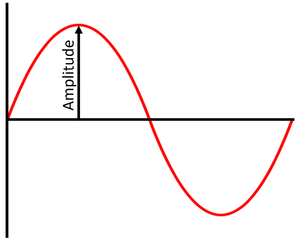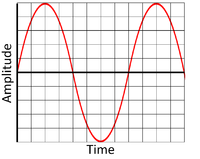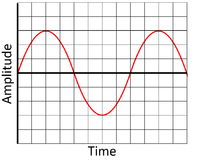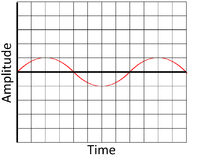Difference between revisions of "Amplitude"
(→About Amplitude) |
|||
| (17 intermediate revisions by 2 users not shown) | |||
| Line 1: | Line 1: | ||
| − | The height of a [[wave]] from the [[equilibrium position| | + | ==Key Stage 3== |
| + | ===Meaning=== | ||
| + | [[File:Amplitude.png|right|300px|thumb|This diagram shows the [[amplitude]] of a [[wave]].]] | ||
| + | The [[amplitude]] of a [[wave]] is the distance between the peak of a [[wave]] and the midpoint of the [[wave]]. | ||
| + | |||
| + | ===About Amplitude=== | ||
| + | : The [[amplitude]] of a [[wave]] gives information on the [[intensity]] of that [[wave]]. | ||
| + | The greater the [[amplitude]] of: | ||
| + | *[[Light]] - The brighter the [[light]]. | ||
| + | *[[Sound]] - The louder the [[sound]]. | ||
| + | *[[Water Wave]] - The taller the [[wave]]. | ||
| + | |||
| + | {| class="wikitable" | ||
| + | |- | ||
| + | |[[File:OscilloscopeScreen4.png|center|200px]] | ||
| + | |[[File:OscilloscopeScreen5.png|center|200px]] | ||
| + | |[[File:OscilloscopeScreen6.png|center|200px]] | ||
| + | |- | ||
| + | | style="height:20px; width:200px; text-align:center;" |This is a high [[amplitude]] [[wave]]. | ||
| + | | style="height:20px; width:200px; text-align:center;" | | ||
| + | | style="height:20px; width:200px; text-align:center;" |This is a low [[amplitude]] [[wave]]. | ||
| + | |} | ||
| + | |||
| + | |||
| + | ==Key Stage 4== | ||
| + | ===Meaning=== | ||
| + | The [[amplitude]] of a [[wave]] is the maximum [[displacement]] of the [[wave]] from its [[Equilibrium Position (Physics)|equilibrium position]]. | ||
| + | |||
| + | ===About Amplitude=== | ||
| + | : The [[amplitude]] of a [[wave]] gives information on the [[intensity]] of that [[wave]]. | ||
| + | The greater the [[amplitude]] of: | ||
| + | *[[Light]] - The brighter the [[light]]. | ||
| + | *[[Sound]] - The louder the [[sound]]. | ||
| + | *[[Water Wave]] - The taller the [[wave]]. | ||
| + | |||
| + | {| class="wikitable" | ||
| + | |- | ||
| + | |[[File:OscilloscopeScreen4.png|center|200px]] | ||
| + | |[[File:OscilloscopeScreen5.png|center|200px]] | ||
| + | |[[File:OscilloscopeScreen6.png|center|200px]] | ||
| + | |- | ||
| + | | style="height:20px; width:200px; text-align:center;" |This is a high [[amplitude]] [[wave]] shown by the large [[displacement]] between the peak (or trough) of the [[wave]] and the [[Equilibrium Position (Physics)|equilibrium position]]. | ||
| + | | style="height:20px; width:200px; text-align:center;" | | ||
| + | | style="height:20px; width:200px; text-align:center;" |This is a low [[amplitude]] [[wave]] shown by the small [[displacement]] between the peak (or trough) of the [[wave]] and the [[Equilibrium Position (Physics)|equilibrium position]]. | ||
| + | |} | ||
| + | |||
| + | ===References=== | ||
| + | ====AQA==== | ||
| + | :[https://www.amazon.co.uk/gp/product/1471851370/ref=as_li_tl?ie=UTF8&camp=1634&creative=6738&creativeASIN=1471851370&linkCode=as2&tag=nrjc-21&linkId=01c69b0ae058f809cf636033e6ba793e ''Amplitude (A), page 183, GCSE Physics, Hodder, AQA'] | ||
| + | :[https://www.amazon.co.uk/gp/product/1782945598/ref=as_li_tl?ie=UTF8&camp=1634&creative=6738&creativeASIN=1782945598&linkCode=as2&tag=nrjc-21&linkId=ad276ad49df77ab4b40ab4fd0fe09676 ''Amplitude (waves), page 219, GCSE Combined Science; The Revision Guide, CGP, AQA'] | ||
| + | :[https://www.amazon.co.uk/gp/product/1782946403/ref=as_li_tl?ie=UTF8&camp=1634&creative=6738&creativeASIN=1782946403&linkCode=as2&tag=nrjc-21&linkId=32a0abb60dff015b15b50e9b1d7b4644 ''Amplitude, page 189, GCSE Combined Science Trilogy; Physics, CGP, AQA'] | ||
| + | :[https://www.amazon.co.uk/gp/product/1782945970/ref=as_li_tl?ie=UTF8&camp=1634&creative=6738&creativeASIN=1782945970&linkCode=as2&tag=nrjc-21&linkId=a120d24dcc7cc7a58192069a3aafc1d2 ''Amplitude, page 226, GCSE Physics; The Complete 9-1 Course for AQA, CGP, AQA'] | ||
| + | :[https://www.amazon.co.uk/gp/product/178294558X/ref=as_li_tl?ie=UTF8&camp=1634&creative=6738&creativeASIN=178294558X&linkCode=as2&tag=nrjc-21&linkId=f0dfb66dafcb0c6e9449e7b1a4ae1ac16 ''Amplitude, page 73, GCSE Physics; The Revision Guide, CGP, AQA'] | ||
| + | :[https://www.amazon.co.uk/gp/product/019835939X/ref=as_li_tl?ie=UTF8&camp=1634&creative=6738&creativeASIN=019835939X&linkCode=as2&tag=nrjc-21&linkId=57e96876985fc39b1a3d8a3e3dc238b6 ''Amplitude, pages 176, 182, GCSE Physics; Third Edition, Oxford University Press, AQA'] | ||
| + | :[https://www.amazon.co.uk/gp/product/0008158770/ref=as_li_tl?ie=UTF8&camp=1634&creative=6738&creativeASIN=0008158770&linkCode=as2&tag=nrjc-21&linkId=ec31595e720e1529e49876c3866fff6e ''Amplitude, pages 191-2, GCSE Physics; Student Book, Collins, AQA'] | ||
| + | :[https://www.amazon.co.uk/gp/product/1471851362/ref=as_li_tl?ie=UTF8&camp=1634&creative=6738&creativeASIN=1471851362&linkCode=as2&tag=nrjc-21&linkId=7d78d70a2044ee9982dae010c94af92a ''Amplitude, pages 257, GCSE Combined Science Trilogy 2, Hodder, AQA'] | ||
| + | ====Edexcel==== | ||
| + | :[https://www.amazon.co.uk/gp/product/1782945741/ref=as_li_tl?ie=UTF8&camp=1634&creative=6738&creativeASIN=1782945741&linkCode=as2&tag=nrjc-21&linkId=30da4f2178da182547b62a7329d13b57 ''Amplitude, page 164, GCSE Combined Science; The Revision Guide, CGP, Edexcel ''] | ||
| + | :[https://www.amazon.co.uk/gp/product/1782945733/ref=as_li_tl?ie=UTF8&camp=1634&creative=6738&creativeASIN=1782945733&linkCode=as2&tag=nrjc-21&linkId=2a2dbec9db6bf5766c0458d908fa0a52 ''Amplitude, page 32, GCSE Physics; The Revision Guide, CGP, Edexcel ''] | ||
| + | :[https://www.amazon.co.uk/gp/product/1292120193/ref=as_li_tl?ie=UTF8&camp=1634&creative=6738&creativeASIN=1292120193&linkCode=as2&tag=nrjc-21&linkId=572df39392fb4200db8391d98ae6314e ''Amplitude, page 331, GCSE Combined Science, Pearson Edexcel ''] | ||
| + | :[https://www.amazon.co.uk/gp/product/1292120223/ref=as_li_tl?ie=UTF8&camp=1634&creative=6738&creativeASIN=1292120223&linkCode=as2&tag=nrjc-21&linkId=068ecf40278c32406a7f1c6e66751417 ''Amplitude, page 49, GCSE Physics, Pearson Edexcel ''] | ||
| + | :[https://www.amazon.co.uk/gp/product/1782948163/ref=as_li_tl?ie=UTF8&camp=1634&creative=6738&creativeASIN=1782948163&linkCode=as2&tag=nrjc-21&linkId=0fdbfd5dd397d6e24a9dfb250f08587f ''Amplitude, page 91, GCSE Physics, CGP, Edexcel ''] | ||
| + | |||
| + | ====OCR==== | ||
| + | |||
| + | :[https://www.amazon.co.uk/gp/product/0198359837/ref=as_li_tl?ie=UTF8&camp=1634&creative=6738&creativeASIN=0198359837&linkCode=as2&tag=nrjc-21&linkId=3c4229e8b023b2b60768e7ea2307cc6f ''Amplitude (waves), pages 142-143, Gateway GCSE Physics, Oxford, OCR ''] | ||
| + | :[https://www.amazon.co.uk/gp/product/1782945695/ref=as_li_tl?ie=UTF8&camp=1634&creative=6738&creativeASIN=1782945695&linkCode=as2&tag=nrjc-21&linkId=ceafcc80bcad6b6754ee97a0c7ceea53 ''Amplitude, page 186, Gateway GCSE Combined Science; The Revision Guide, CGP, OCR ''] | ||
| + | :[https://www.amazon.co.uk/gp/product/1782945687/ref=as_li_tl?ie=UTF8&camp=1634&creative=6738&creativeASIN=1782945687&linkCode=as2&tag=nrjc-21&linkId=9a598e52189317a20311d7a632747bc9 ''Amplitude, page 59, Gateway GCSE Physics; The Revision Guide, CGP, OCR ''] | ||
| + | |||
| + | |||
| + | ==Key Stage 5== | ||
| + | ===Meaning=== | ||
| + | [[Amplitude]] is the maximum [[displacement]] from [[Equilibrium Position (Physics)|equilibrium]] in an [[oscillating]] [[system]]. | ||
| + | |||
| + | ===About Amplitude=== | ||
| + | |||
| + | *Measures the strength or [[intensity]] of a [[wave]]. | ||
| + | *Larger [[amplitude]] means more [[energy]] is carried by the wave. | ||
| + | *Can be [[measure]]d in various units depending on the type of [[wave]] (e.g., [[metre]]s for [[Mechanical Wave|mechanical waves]], [[volt]]s for electrical signals). | ||
| + | *In a [[Sound|sound wave]], [[amplitude]] determines the loudness. | ||
| + | *In a [[Visible Light|light wave]], [[amplitude]] affects the brightness. | ||
| + | *[[Amplitude]] can be affected by damping, which reduces the [[amplitude]] over [[time]]. | ||
| + | *In [[Simple Harmonic Motion|simple harmonic motion (SHM)]], [[amplitude]] remains constant if no [[energy]] is lost. | ||
| + | *[[Amplitude Modulation|'''Amplitude''' modulation (AM)]] is a technique used in electronic communication, most commonly for transmitting information via a [[radio]] [[Carrier Wave|carrier wave]]. | ||
| + | |||
| + | ===Examples=== | ||
| + | |||
| + | *The loudness of a [[sound]] is related to the [[amplitude]] of the [[sound]] wave. | ||
| + | *The brightness of a [[Visible Light|light]] [[wave]] increases with its [[amplitude]]. | ||
Latest revision as of 10:56, 19 May 2024
Contents
Key Stage 3
Meaning
The amplitude of a wave is the distance between the peak of a wave and the midpoint of the wave.
About Amplitude
The greater the amplitude of:
| This is a high amplitude wave. | This is a low amplitude wave. |
Key Stage 4
Meaning
The amplitude of a wave is the maximum displacement of the wave from its equilibrium position.
About Amplitude
The greater the amplitude of:
| This is a high amplitude wave shown by the large displacement between the peak (or trough) of the wave and the equilibrium position. | This is a low amplitude wave shown by the small displacement between the peak (or trough) of the wave and the equilibrium position. |
References
AQA
- Amplitude (A), page 183, GCSE Physics, Hodder, AQA'
- Amplitude (waves), page 219, GCSE Combined Science; The Revision Guide, CGP, AQA'
- Amplitude, page 189, GCSE Combined Science Trilogy; Physics, CGP, AQA'
- Amplitude, page 226, GCSE Physics; The Complete 9-1 Course for AQA, CGP, AQA'
- Amplitude, page 73, GCSE Physics; The Revision Guide, CGP, AQA'
- Amplitude, pages 176, 182, GCSE Physics; Third Edition, Oxford University Press, AQA'
- Amplitude, pages 191-2, GCSE Physics; Student Book, Collins, AQA'
- Amplitude, pages 257, GCSE Combined Science Trilogy 2, Hodder, AQA'
Edexcel
- Amplitude, page 164, GCSE Combined Science; The Revision Guide, CGP, Edexcel
- Amplitude, page 32, GCSE Physics; The Revision Guide, CGP, Edexcel
- Amplitude, page 331, GCSE Combined Science, Pearson Edexcel
- Amplitude, page 49, GCSE Physics, Pearson Edexcel
- Amplitude, page 91, GCSE Physics, CGP, Edexcel
OCR
- Amplitude (waves), pages 142-143, Gateway GCSE Physics, Oxford, OCR
- Amplitude, page 186, Gateway GCSE Combined Science; The Revision Guide, CGP, OCR
- Amplitude, page 59, Gateway GCSE Physics; The Revision Guide, CGP, OCR
Key Stage 5
Meaning
Amplitude is the maximum displacement from equilibrium in an oscillating system.
About Amplitude
- Measures the strength or intensity of a wave.
- Larger amplitude means more energy is carried by the wave.
- Can be measured in various units depending on the type of wave (e.g., metres for mechanical waves, volts for electrical signals).
- In a sound wave, amplitude determines the loudness.
- In a light wave, amplitude affects the brightness.
- Amplitude can be affected by damping, which reduces the amplitude over time.
- In simple harmonic motion (SHM), amplitude remains constant if no energy is lost.
- Amplitude modulation (AM) is a technique used in electronic communication, most commonly for transmitting information via a radio carrier wave.



